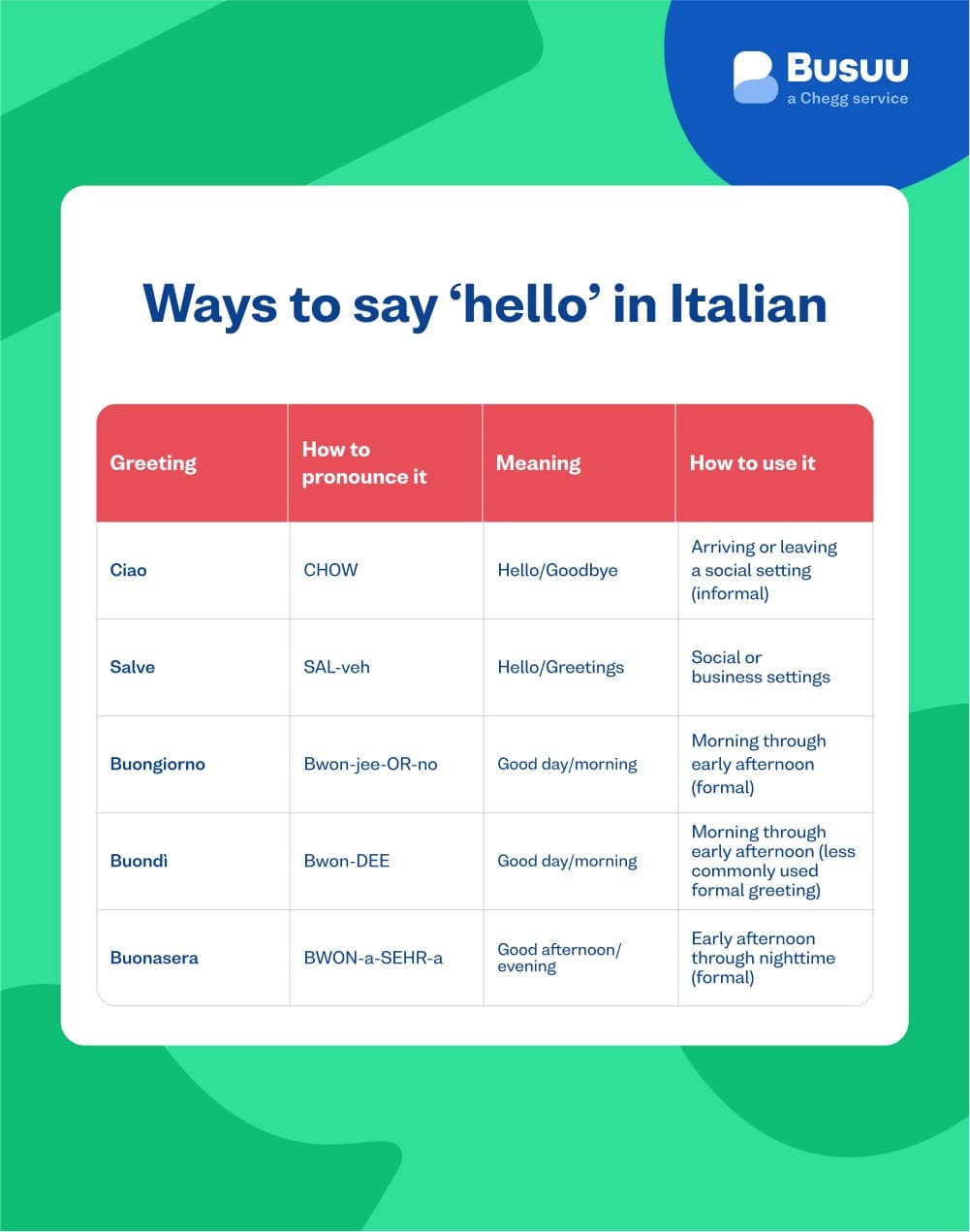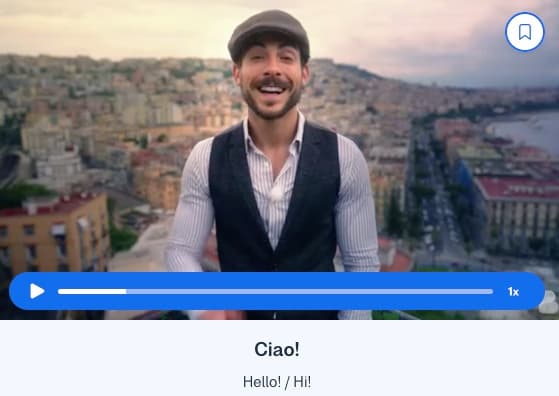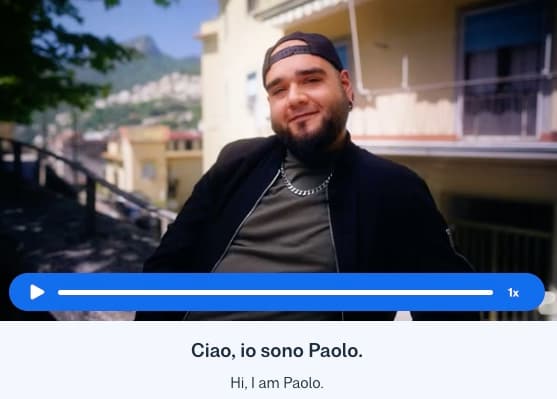I want to learn...
Even if you’re an absolute beginner to learning Italian, saying hello can set you up for success before switching to your native language or asking for help. You need to choose the right greeting, though. Too informal, and you could offend the person you’re speaking to. Too formal, and you risk sounding cold.
Italians are polite and show respect to elders with their greetings, but they also have fun with language and have lots of beautiful phrases to greet friends with affection.
Ciao, bella! You’ve likely heard this world-famous greeting, but saying hi in Italian is a little more nuanced.
How to say an informal hi in Italian
Just like in English, Italian has several informal ways to say hi. The most common Italian greeting is Ciao ( pronounced CHOW). Ciao is a simple, snappy way of saying hello and goodbye in Italian. It comes from the Venetian word sciavo—literally meaning servant or slave. It’s the modern Italian version of signing off ‘your humble servant’.
It’s common to pair Ciao with other words to make a whole greeting. For example, Ciao, come va? is a slightly informal way of saying ‘Hello/Hi, how's it going?’ to someone you know. Ciao, come stai? is another informal way to say “Hi, how are you?”.
Ciao bella/bello or Ciao cara/caro are terms of endearment for greeting a loved one.
You can also say Salve, which is in between formal and informal in Italian. It’s a good choice if you’re unsure about the setting or ‘when in Rome’—that’s where it originates. This comes from the Latin salvere, meaning to be well or be in good health (also the root of the English ‘salutation’).
Ehi is the Italian adoption of the English word ‘hey’. You may use this with friends if you’re trying to catch their attention from down the street, but keep in mind that it can also express annoyance depending on the context.
How to say a formal hello in Italian
If you’re meeting someone for the first time or greeting an elder, a more senior colleague, or someone working in a restaurant or hotel, you’ll want to stick with formal greetings.
The most common way to say hello in a formal context is Buongiorno, which means good day. Another form is Buondì, though it’s much less common. When you walk into a shop, an employee may greet you with Benvenuto, meaning welcome.
It’s also polite to greet someone as Signore (Sir/Mr.) or Signora (Ms./Madam) when addressing someone. For example, Buongiorno, Signora Ferrari (Good morning, Ms. Ferrari), or Mi scusi, Signore (Excuse me, Sir).
When greeting someone formally, it’s important to use the formal pronoun form Lei instead of tu (you informal) to show respect. For instance, you’ll say Come sta? instead of Come stai? for ‘How are you?’. For someone you’ve already met, you can say Felice di vederti (nice to see you).
Italian greetings by time of day
While Buongiorno is the most common formal greeting, it’s only appropriate at certain times of day. The timing of the switch can vary by region: Some areas start using Buonasera after lunch, while others won’t until 4 or 5 pm.
Buongiorno is used for mornings through the afternoon
Buon pomeriggio means good afternoon, but it’s rarely used
Buonasera means good afternoon and good evening. Use Buonasera to greet someone even if it’s late and dark outside. Buonanotte is only used to say good night (as in goodbye).
You’ll sometimes see these time-of-day greetings written as one word (Buongiorno) or two (Buon giorno). Both are accepted and correct, so don’t worry about how to write it!

20 Ways to say hello in Italian
| Greeting | How to pronounce it | Meaning | How to use it |
|---|---|---|---|
| Ciao | CHOW | Hello/Goodbye | Arriving or leaving a social setting, informal |
| Salve | SAL-veh | Hello/Greetings | Social or business settings |
| Buongiorno | Bwon-jee-OR-no | Good day/morning | Formal greeting, morning through early afternoon |
| Buondì | Bwon-DEE | Good day/morning | Less commonly used formal greeting, morning through early afternoon |
| Buonasera | BWON-a-SEHR-a | Good afternoon/evening | Formal greeting, early afternoon through nighttime |
| Buon pomeriggio | BWON POHM-eh-ree-jo | Good afternoon | Less commonly used formal greeting, afternoon |
| Piacere/Piacere di conoscerti (informal)/Piacere di conoscerLa (formal) | PI-a-CHER-eh dee kon-OH-sher-tee | Nice to meet you | Meeting someone new, formal or informal |
| Lieto di conoscerti (informal)/Lieto di conoscerLa (formal) | lee-EH-toh dee kon-OH-sher-tee | Nice to meet you | Meeting someone new, formal or informal |
| Pronto? | PRON-toh | Hello (literally ‘ready’) | When answering the phone |
| Felice di vederti | feh-LEE-cheh dee veh-DEHR-tee | Nice to see you | Greeting someone you’ve already met |
| Ehi | EH-ee | Hey | Catching someone’s attention that you know or expressing surprise |
| Benvenuto | BEHN-vehn-OO-toh | Welcome | Welcoming a guest |
| Mi chiamo… | MEE kee-AM-oh | My name is… | Meeting someone new |
| Egregio | EH-GRE-jee-OH | Dear… | Opening greeting for a letter or email, formal |
| Mi scusi | MEE SKOO-zee | Excuse me | A polite way to get someone’s attention |
| Ciao bella/bello | CHOW BEHL-la/BEHL-loh | Hello beautiful | Platonic greeting of affection |
| Ciao cara/caro | CHOW KAHR-ah/ KAHR-oh | Hello dear | Platonic or romantic greeting of affection |
| Come va? | KOM-eh VAH? | How’s it going? | Informal with friends |
| Come sta? | KOM-eh STAH? | How are you? | Formal with bosses, professors, strangers |
| Come stai? | KOM-eh STAH-ee? | How are you? | Informal with friends |
How to introduce yourself in Italian
When you meet someone for the first time, you want to make a good impression. Fortunately, it’s simple in Italian. Start with a formal hello (Buongiorno/Buonasera), then say mi chiamo (my name is) followed by your name.
If someone introduces you or the other person introduces yourself first, you can say Piacere di conoscerti or simply, Piacere. This means nice to meet you, and the other person will say it back.
Here’s an example:
Andrea: Buongiorno, mi chiamo Andrea.
Luca: Piacere di conoscerti. Mi chiamo Luca.
Andrea: Piacere.
When Italians meet someone for the first time, they normally greet with a handshake. Once you are friends, you’ll greet with two air kisses on the cheek, known as il bacetto. Don’t worry, you’ll get the hang of it quickly.
Learn more: 7 Italian hand gestures you should know about
Bonus greetings for goodbye in Italian
Once you’ve said hello in Italian, you also need to know how to say goodbye.
Arrivederci – Goodbye
Buona serata – Have a good night
Ci vediamo (domani) – See you (tomorrow)
A presto – See you soon
Alla prossima – Until next time
Ti saluto/vi saluto – Informal for ‘bye,’ meaning ‘’I salute you’
Stammi bene/Statemi bene – Take care
È stato un piacere – It’s been a pleasure
Cordiali saluti – Warm regards (closing a formal email or letter)
Cordialmente – Cordially (closing a formal email or letter)
Saluti – Regards (closing an email, less formal)
Even if you can’t say much else in Italian yet, saying hi in Italian can build trust and show respect for the language and culture. Once you’ve mastered Ciao, Buongiorno, and Buonasera, you can start to learn basic conversation topics.
Newlanguages


